I. Geological overview of the deposit
The mining area is located in the Hexi Corridor. There are highways connected, 10kV power supply lines, and river water and small spring water can meet the production and living needs. C + D grade geological reserves have been proved: the amount of gold metal is about 1.5t, and the amount of silver metal is 70t.
The deposit is mesothermal fracture filling and replacement fracture zone altered rock type polymetallic deposits, ore body in Cambrian DAHUANGSHAN heteroaryl group feldspar quartz sandstone quartz veins. The secondary structure energy generation, fault and structural fracture zone in the area provide a favorable place for the enrichment of gold and silver. The mineralized belt is several hundred meters long, and there are two large ore bodies, which are irregularly veined and have large changes in expansion and contraction. Ore body and wall rock alteration is developed, its size and strength depends on the size and degree of fragmentation of rock structure, mainly silicification, chlorite, limonite mineralization, accompanied by gold and silver mineralization. The ore oxidation rate is 72.3% in terms of lead , 84.7% in terms of zinc , and 65.7% in terms of copper .
Second, the ore material composition
(1) Ore chemical composition
The results of multi-element chemical analysis of ore are shown in Table 1.

(2) Mineral composition and content
There are 53 species of minerals identified, see Table 2 and Table 3.



(3) Ore structure
Ore often forms colloidal and gelatinous, shell-like, honeycomb-like, earthy, loose, breccia, residual, alternating veins, alternating strips and other structures, followed by disseminated structures, filled vein structures, etc. structure.
The common ore structure has self-opening, semi-self-shape, his shape-like structure, metasomatism, residual structure, reaction edge structure, filling structure and inclusion structure.
(4) Metallic mineral inlay characteristics
White lead ore and lead bismuth: the two are closely symbiotic, mostly produced by granular aggregates, and the particle size is generally between 0.01 and 0.2 mm. Most of the lead ore along the edge of the lead ore distribution is one of the carrier minerals of silver, which is wrapped with a small amount of sulfur copper and silver ore, natural silver and so on.
Arsenic chloride lead ore: mostly in the form of granular inlays in white lead ore, lead or in the side, generally less than 0.05mm in size, including natural silver inclusions.
Galena: uneven distribution, particle size varies from 0.02 to 0.1 mm. Galena is often replaced by leuco-lead, lead-bismuth, copper-blue, and sphalerite along edges or fissures. Wherein the silver-antimony often wrapped tetrahedrite, native silver, copper and other mineral fines blue inclusions.
Malachite, chrysocolla, azurite: mostly veined, irregularly filled in the gangue gap, partially interlaced with limonite, not easy to dissociate. Some are interbedded with malachite, some are scattered in the gangue gap, and some are produced along the edge or crack of chalcopyrite, galena, orite, which contains silver.
Rhomite, zinc-zinc ore: the main mineral of zinc, uneven distribution, both of which are symbiotic, also produced separately, with a particle size between 0.01 and 0.2 mm. Most of them are irregular granular filling or metamorphosed along the gangue gap.
Sphalerite: mainly composed of granules embedded in the gangue, often replaced by smithsonite, or simply associated with chalcopyrite and pyrite, with a particle size of less than 0.03 mm. Zinc minerals have a simple relationship with natural gold and silver minerals.
Limonite: Close to natural gold. The shape is complex, with veins and veins interspersed along the ore fissures; those with irregular granularity, the particle size is generally less than 0.1mm, and the natural gold is visible in the gap between the gangue; also the edge along the pyrite and the fracture or intermediate structure The weak places are accounted for, forming an illusion, and the half-imaginary confession structure. The limonite in this period is often associated with natural gold.
Pyrite: It is also one of the carrier minerals of gold. Mostly self-formed, semi-automorphic grains, particle size is not uniform, generally between 0.03 ~ 0.20mm. It has a simple relationship with other metal minerals. The natural gold in the pyrite is mostly in the form of monomers, and some parts appear in groups.
Aromatic sand, scorodite: the main carrier mineral of arsenic, the poisonous sand is mainly self-shaped, semi-self-shaped granular embedded in the gangue. The particle size is more than 0.1 mm, indicating that the oxidation is from the onion stone, in which the gold is wrapped.
Quartz: the main carrier of natural gold, the natural gold monomer or group can be seen in the intergranular space or its minerals, the angular silver deposit can be seen in the intergranular gap, and the surface of the rough surface is copper blue, which contains natural silver.
Third, the study of the occurrence of gold and silver
(1) Gold and silver mineral types and embedding characteristics
Through research, it is found that gold is an independent gold mineral - natural gold, a small amount of silver gold ore. The average color is 860%.
There are many kinds of silver minerals, including natural silver, silver bismuth copper ore, horn silver ore, sulphur copper silver ore, sulphur arsenic copper silver ore, fluorite ore, silver-bearing copper blue, silver-containing bismuth copper ore, silver-lead-lead ore. Silver shovel and so on. The results of electron probe analysis of gold and silver mineral species and their main elements are shown in Table 4.

Natural gold, silver and gold deposits: small amount, complex shape, fine particle size, mainly produced in quartz, limonite, followed by occasional inclusions in pyrite, arsenopyrite, horn silver ore. Often appear alone, sometimes in groups.
Natural silver: Most of the micro-encapsulated bodies are encapsulated in lead minerals, or in contact with beryllium ore and angle silver ore.
Angular silver ore: Irregularly measured granular, coarse grain size up to 0.1mm, average 0.05mm, produced in the gangue gap, a small amount of natural silver, leucite, limonite and so on. It contains natural gold particles, as shown in Figure 1.
Yinyu Copper Mine: It is encapsulated in galena in the form of particles, or galena in the galena cracks. Occasionally, it is simply associated with chalcopyrite, and the particle size is less than 0.05mm. The composition of As is very low, containing a small amount of Fe, and its chemical formula is calculated as: (Cu 7.48 Ag 2.73 Fe 0.74 Zn 0.14 Pb 0.02 Bi 0.005 ) 11.115 (Sb 3.64 As 0.34 ) 3.98 S 13 .
Sulfur copper-silver ore, sulfur-arsenic-copper-silver ore: the former is irregularly granular, with a fine particle size, less than 0.05mm, and is distributed along the edge or crack of the white lead ore, as shown in Figure 2. The latter is mostly filled with fine veins between the pyrite fractures.


Silver-bearing minerals: The deposit is more common with silver minerals, including silver-brown blue, silver-containing bismuth copper ore, silver-containing white lead ore, etc. Even in the probe scanning process, it is found that the gangue also contains silver.
(2) Natural gold and silver mineral inlay characteristics
The gold mineral inlay characteristics are shown in Table 5. The statistical results show that more than 2/3 of the gold has an embedded relationship with limonite and quartz, and the packaged gold is more than the intergranular gold and the cracked gold. Silver minerals are mainly encapsulated in galena, with a small amount of intergranular, continuous crystal and vein.

(3) Grain size characteristics of natural gold and silver minerals

(4) Morphological characteristics of gold and silver minerals
The forms of natural gold are diverse, and the effects of combined forms on beneficiation are reduced to three types: irregular granules account for 55.0%, leaf-like granules account for 26.5%, microvessels account for 18.5%; silver mineral granules and leaf-like occupies 89.2%, microvein Accounted for 10.8%.
(5) Distribution of gold and silver
1. Gold and silver are distributed in ore
Gold and silver are selectively distributed in the ore. Gold is higher in the fragmented ore with quartzite breccia and iron oxide massive ore. The higher the content of silver in the ore with stronger oxidation, the gray-white lead oxide ore. The highest in the middle, some reached hundreds or even kilograms per ton, followed by honeycomb-like clay-bearing limonite ore.
2. Distribution and balance of gold and silver in carrier minerals
Through the analysis of gold and silver phase and single mineral analysis, electron probe quantitative analysis, the calculation of metal balance balance can explore the degree of gold and silver enrichment in the main carrier minerals, and scientifically predict the ideal recovery index of gold and silver. The gold recovery rate is expected to be 54.7%, and the silver recovery rate (excluding some of the angular silver ore) is 85.0% (see Table 7).

4. Mineralogical evaluation of rational development and utilization of the ore
Although the valuable elements of the ore are Pb, Cu, Zn, Au, Ag, etc., the Cu, Zn grades are low (0.34%, 0.47%), and the minerals are mostly oxidized. The sulfide mineral of copper is copper blue, and its particle size is fine. The gangue mosaic is complicated, and the oxidized minerals are malachite, chrysocolla and a small amount of blue-copper ore. They are often mixed with limonite and gangue to form combined copper (25% of total copper); Mines and zinc-zinc deposits are dominant, and rhombohite often appears in a ring-like structure with limonite. Regardless of the non-uniformity of Cu and Zn distribution in the ore, or from the appearance and embedding characteristics of the relevant minerals, Cu and Zn are not easily recovered.
The ore is a strong oxidized ore, the metal sulfide has been oxidized, but there are some metal sulfides, and the sulfide is also the carrier of gold and silver (the ore 85%-0.074mm (-200 mesh) sulfide accounts for 20% of the gold. Silver accounted for 72%), which can preferentially float out sulphide, gold concentrate and lead concentrate. When tailings inspection, it was found that gold was present in quartz and limonite in the form of package, and the silver part was angled. Silver ore (original ore 85%-0.074mm (-200 mesh) angle silver mine accounts for 15% of total silver), and full mud cyanide production can be considered. In addition, there are also valuable minerals such as white lead ore, lead bismuth, copper oxide, limonite, and zinc-zinc ore and quartz-based gangue in tailings products. The silver is detected by electron probe scanning. We must pay attention to the recovery of this part of minerals.
V. Conclusion
(1) Research on the occurrence of gold and silver shows that gold is an independent mineral - natural gold and silver gold ore; carrier minerals are quartz, limonite, pyrite; mainly wrapped gold, intergranular gold, less crack gold; It is mainly composed of irregular grains, and the particle size belongs to medium-fine particle-level inlays.
Silver is mainly composed of independent minerals, natural silver, silver bismuth copper ore, horn silver ore, sulphur copper and silver ore, sulphur arsenic, copper and silver ore, followed by silver-bearing copper blue, silver-containing white lead ore, silver-containing bismuth copper ore. Wait. In addition to the close relationship with lead minerals, silver minerals are also dispersed in copper minerals. Even star-shaped silver minerals are found in gangue. Silver carrier minerals are in order of galena, galena, Arsenic chloride lead, copper blue, gangue and so on.
(2) Considering the comprehensive consideration of the nature of the ore, the ore is more suitable for the overall mud cyanide production after flotation. In actual production, attention should also be paid to the beneficiation problems such as the recovery of the medium-grain gold 4 and the effective dissociation of the fine-grained gold in the limonite, the gangue, the recovery of the horny silver ore, and the influence of arsenic.
The trends of the Metal Scrap recycling industry
Recycled scrap consists of 58% of post-consumer products that are considered to be obsolete or outdated. 24% of this material is prompt scrap, which is produced in manufacturing plants that create steel. 18% of the industry involves home scrap, which is produced by current operations.
Steel and aluminum can be infinitely recycled. Scrap metal consists of ferrous metals or nonferrous metals. Large items such as cars, dishwashers, washing machines, stoves, and refrigerators are generally created from metal and therefore the best items to recycle.
By baling the products, the volume of metal scrap is greatly reduced, often up to seventy-five per cent.
By reducing the volume in this way, the smelting costs are reduced. In addition, the overall process of recycling and re-casting can be done more quickly.
Manual Metal balers are economically and environmentally beneficial in reducing metal waste. They lower costs, are space-efficient and make transporting the materials much easier.
The Manual Metal Baling press makes your metal recycling more efficient and profitable.
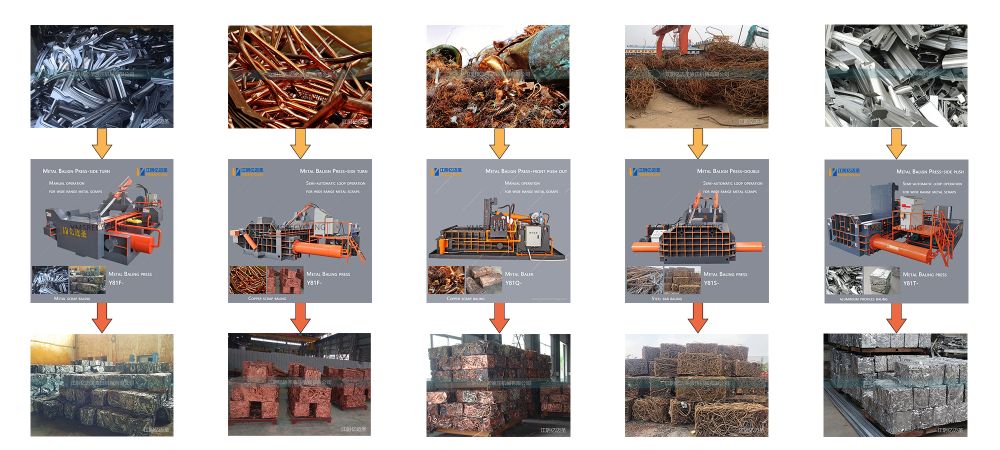
The Y81 series Manual Waste Metal Scrap Baler could not only press all non-ferrous metals such as copper, brass, and aluminium can be recycled as well as ferrous metals from steel to stainless steel, with various sizes for option, high-density compression, compact and strong. Low energy consumption but fast production rate.
Y81 series hydraulic metal baler mainly include the following models.
Y81F (side turn discharge ), Y81T (side push discharge), Y81Q (front push discharge) and Y81S (Double main press ).
We also support the design and manufacture of other model versions upon request.
Y81Q-Manual operation (Front push discharge )
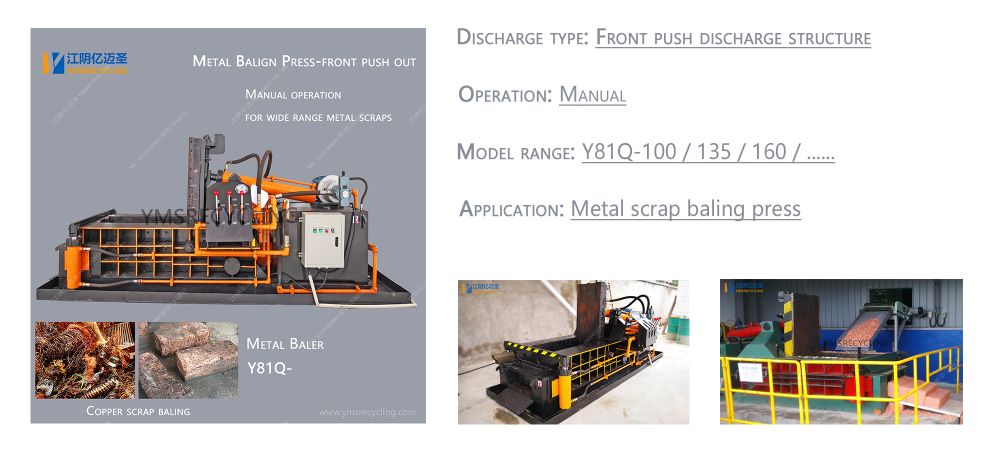
Y81F-Manual operation (Side turn discharge )
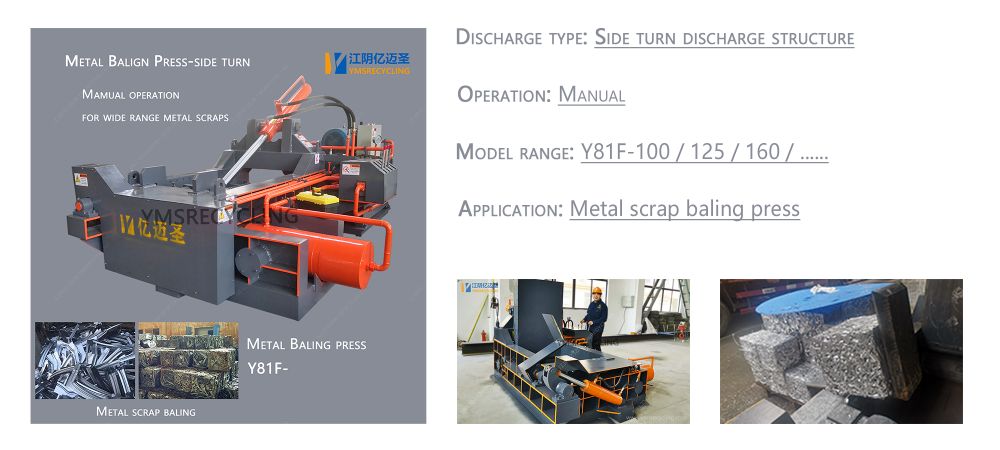
Y81F-Semi-automatic operation (Side turn discharge )
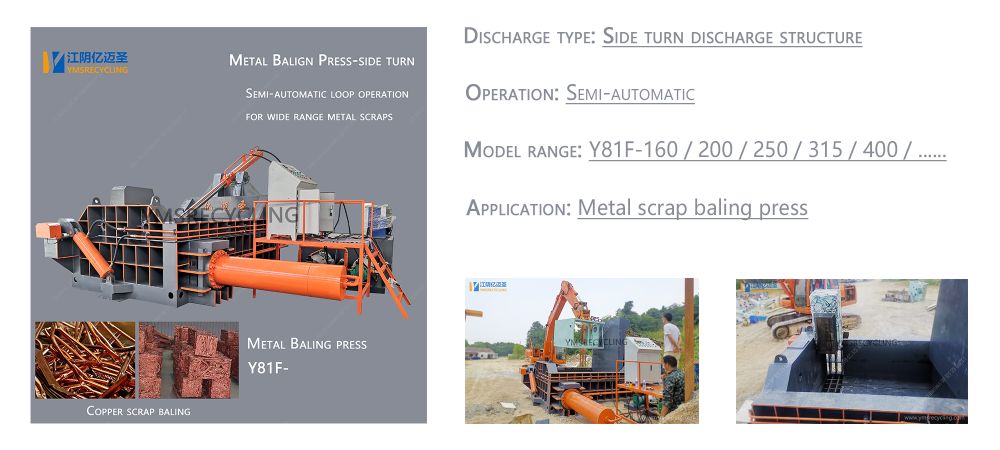
Y81T-Semi-automatic operation (Side push discharge )
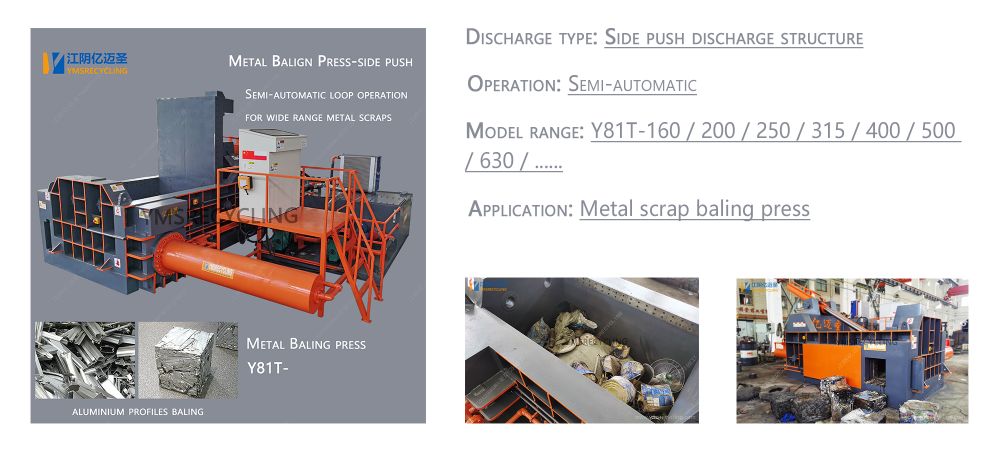
Y81S-Semi-automatic operation (Double main press discharge )
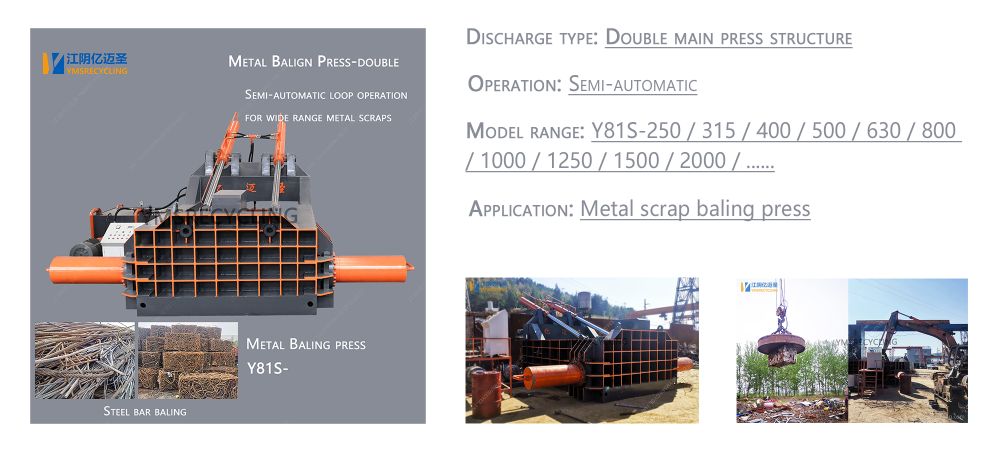
We provide a variety of models of the hydraulic metal baler, With new technologies to raise the quality and reduce the price, which supports 24 hours fully automatic working environment.
YMSRECYCLING offer economical and effective solutions to help you to process different metal scraps.
The Metal Baling Press can be customized and extended according to the actual needs of your on-site.
CONTACT YMSRECYCLING
Call us now on +86-15950122559
To start maximising your returns from your metal scrap recycling.
Please email sales@ymsrecycling.com or visit our website directly for further information about the products you are interested in.
Manual Metal Baler,Manual Waste Metal Baler,Manual Metal Baling Press,Manual Metal Recycling Baler
Jiangyin Yimaisheng Hydraulic Machinery Co., Ltd. , https://www.ymsrecycling.com